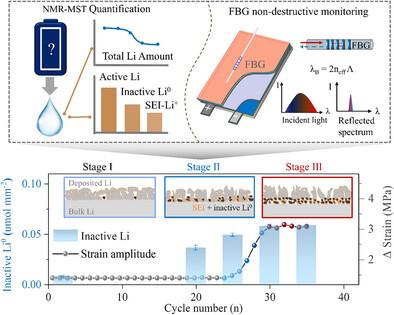袋式锂金属电池失效过程的定量无损分析
IF 26
1区 材料科学
Q1 CHEMISTRY, PHYSICAL
引用次数: 0
摘要
锂金属电池(lmb)是新兴的下一代储能技术。了解操作条件下的失效机制和量化锂金属阳极(lma)的实时演变对于提高袋式lmb的性能和安全性至关重要。本研究采用液体核磁共振-滴定质谱法(NMR-TMS)定量表征了不同条件下非活性和活性锂的动态演化。通过扫描电子显微镜(SEM)与相场模拟相结合,阐明了潜在的失效机制。重要的是,光纤布拉格光栅(FBG)传感技术实现了在不同电流密度下对袋式lmb内应力演变的实时、无损监测。本研究为快速充电条件下的三阶段失效机理提供了直接的实验验证。通过优化的充放电方案,LMAs的失效行为得到了显著的缓解,在贫电解质条件下(即2.1 g Ah−1)产生了LiNi0.8Mn0.1Co0.1O2 (NMC811) ||锂袋电池,在0.2C/1C(充放电)条件下,电池容量保持率为90.5%,可循环300次。机理分析不仅建立了故障检测的系统方法,而且为下一代高安全性lmb的性能优化和故障缓解提供了战略指导。本文章由计算机程序翻译,如有差异,请以英文原文为准。

Quantitative and Non-Destructive Analysis of Failure Process of Pouch Lithium Metal Batteries
Lithium metal batteries (LMBs) are emerging as a promising next-generation energy storage technology. Understanding failure mechanisms under operational conditions and quantifying the real-time evolution of lithium metal anodes (LMAs) are critical for enhancing the performance and safety of pouch-type LMBs. In this study, liquid nuclear magnetic resonance–titration mass spectrometry (NMR-TMS) is employed to quantitatively characterize the dynamic evolution of inactive and active Li under various conditions. By combining scanning electron microscopy (SEM) with phase-field simulations, the underlying failure mechanisms are elucidated. Importantly, fiber Bragg grating (FBG) sensing technology is implemented to achieve real-time, non-destructive monitoring of internal stress evolution in pouch-type LMBs under varying current densities. This study provides direct experimental validation of the three-stage failure mechanism under fast charging conditions. Through optimized charge/discharge protocols, LMAs failure behavior is significantly mitigated, leading to a LiNi0.8Mn0.1Co0.1O2 (NMC811) || Li pouch cell in lean electrolyte conditions (that is, 2.1 g Ah−1), with 90.5% capacity retention for 300 cycles at 0.2C/1C (charge/discharge) condition. The mechanistic insights not only establish systematic methods for failure detection but also offer strategic guidance for performance optimization and failure mitigation in next-generation LMBs of high-safety.
求助全文
通过发布文献求助,成功后即可免费获取论文全文。
去求助
来源期刊

Advanced Energy Materials
CHEMISTRY, PHYSICAL-ENERGY & FUELS
CiteScore
41.90
自引率
4.00%
发文量
889
审稿时长
1.4 months
期刊介绍:
Established in 2011, Advanced Energy Materials is an international, interdisciplinary, English-language journal that focuses on materials used in energy harvesting, conversion, and storage. It is regarded as a top-quality journal alongside Advanced Materials, Advanced Functional Materials, and Small.
With a 2022 Impact Factor of 27.8, Advanced Energy Materials is considered a prime source for the best energy-related research. The journal covers a wide range of topics in energy-related research, including organic and inorganic photovoltaics, batteries and supercapacitors, fuel cells, hydrogen generation and storage, thermoelectrics, water splitting and photocatalysis, solar fuels and thermosolar power, magnetocalorics, and piezoelectronics.
The readership of Advanced Energy Materials includes materials scientists, chemists, physicists, and engineers in both academia and industry. The journal is indexed in various databases and collections, such as Advanced Technologies & Aerospace Database, FIZ Karlsruhe, INSPEC (IET), Science Citation Index Expanded, Technology Collection, and Web of Science, among others.
 求助内容:
求助内容: 应助结果提醒方式:
应助结果提醒方式:


